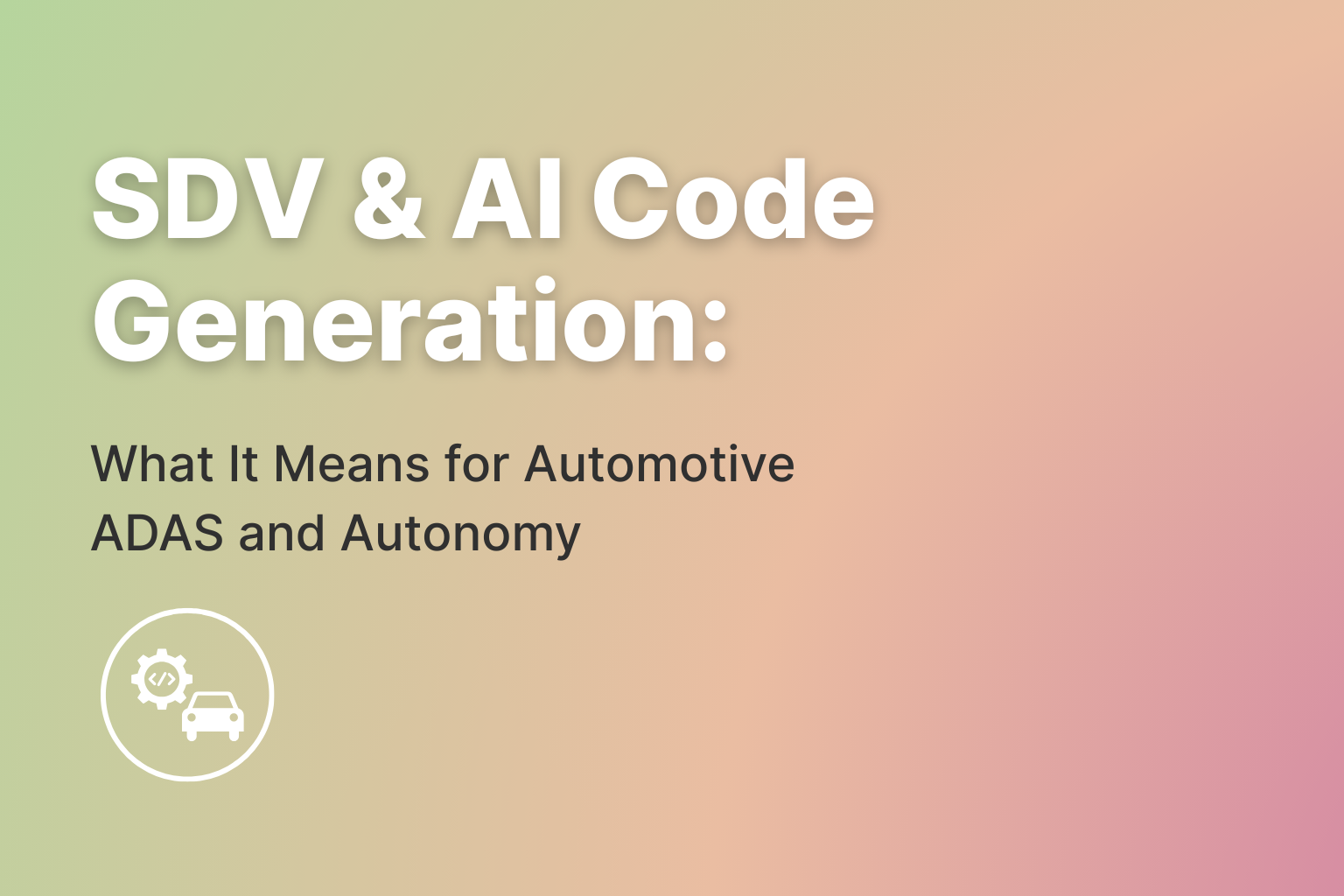TL;DR
- AI speeds up embedded C/C++ development, but generated code can hide performance, timing, and compliance issues.
- Set clear boundaries between AI and engineers: AI can produce boilerplate, while engineers retain control over critical design, safety, and timing decisions.
- Integrate static and dynamic analysis early to catch inefficiencies, rule violations, and unpredictable behavior before deployment.
- Implement a continuous optimization loop combining analysis, targeted optimization, and hardware-aware code generation.
- Enforce real-time and hardware constraints at every iteration to prevent technical debt and ensure reliable behavior.
- Automate review and feedback: AI and analysis tools handle generation and validation, while engineers focus on final approval.
- Use hardware-aware tools like beLow for real metrics on CPU, memory, energy, and performance.
- Document and certify AI contributions to maintain traceability and compliance in regulated industries.
- Outcome: a hybrid workflow where engineers guide, AI accelerates, and tools ensure predictable, safe, and optimized embedded code.
Introduction
AI code generation is no longer experimental. It’s now embedded (literally) in the daily workflow of engineering teams building automotive ECUs, flight software, robotic motion controllers, and industrial systems.
In the first two articles of this series — The Boom of AI Code Generation in Embedded Software and The Hidden Performance Gap in AI-Generated Code — we explored the rise of AI code assistants and the hidden performance issues lurking inside AI-generated C/C++ code. This third part takes the logical next step: how to design a development workflow where AI accelerates your team without compromising real-time guarantees, safety rules, or hardware constraints.
Because in embedded systems, speed is valuable, but predictability is everything. A new workflow is not a “nice to have.” It’s the foundation that makes AI usable in regulated, resource-constrained environments. And with the right tooling, especially hardware-aware analysis and optimization engines like beLow, this workflow becomes not just safe, but dramatically more efficient.
Why AI Code Generation Needs a Structured Workflow
AI has rewritten the rules of software creation. A single prompt can now produce a UART driver, a PID loop, or a CAN diagnostic handler. But for embedded systems, this convenience hides a deeper truth: AI can generate correct-looking code that is fundamentally incompatible with real hardware.
This is why a structured workflow is necessary, not to slow teams down, but to protect them from problems invisible at compile time.
1. Undefined behavior and rule violations
AI models don’t naturally follow MISRA, AUTOSAR, CERT C, or project-specific guidelines. They prioritize syntactic correctness and “common patterns,” not deterministic behavior.
The risk? Hidden violations that make code fail certification later, when fixes are far more expensive.
2. Missed deadlines and unpredictable timing
Generative models don’t understand that an ISR has a 12 µs budget or that a control loop must execute every 5 ms. They may add abstraction layers, unnecessary branches, or dynamic memory. On a desktop app, this is harmless. On an ECU or RTOS, it can cause instability.
3. Inefficiency that only appears on hardware
AI-generated code often compiles fine… and performs terribly. Real inefficiencies show up only under hardware constraints: memory bus contention, stack pressure, context-switch overhead, or peripheral latency. This can produce the illusion of working software, until the moment it needs to behave deterministically.
4. Opacity for certification
Certifiers want traceability. AI generates solutions, not explanations. Without a workflow to document and validate those contributions, compliance becomes nearly impossible.
All of this leads to one conclusion: AI doesn’t replace the engineering process. It forces us to redesign it.
Step 1 — Define Clear Boundaries Between AI and Engineer
The first step in building a safe AI-assisted workflow isn’t technical — it’s strategic. Before integrating generative models into an embedded C/C++ pipeline, teams need to decide where AI adds value and where human judgment must remain in control. Most issues with AI-generated code don’t come from the model itself, but from unclear expectations about how it should be used.
In early experiments, developers let AI assist “wherever it seemed helpful”: rewriting loops, drafting drivers, restructuring modules, or generating control logic from a prompt. The initial speed boost was undeniable, until the code hit real hardware. Hidden MISRA violations, unpredictable timing, unsafe memory usage, or abstractions incompatible with an RTOS quickly revealed that not all AI-generated patterns belong in embedded environments.
AI is excellent for boilerplate, utility functions, first drafts of drivers, or repetitive C/C++ patterns. But architecture, safety decisions, timing guarantees, and system-level design must stay in human hands. AI can produce a CAN handler; only an engineer can guarantee it meets a 5 ms deadline on a specific MCU.
Framed this way, boundaries become an enabler, not a constraint. They allow engineers to focus on high-value decisions, while AI accelerates low-level generation.
A practical way to enforce this separation is through an AI Sandbox: a dedicated branch where all AI-generated C/C++ code must land before reaching production. The sandbox isolates risk while encouraging experimentation. It creates a controlled space where contributions can be:
- inspected for correctness,
- validated against project or industry rules,
- analyzed for timing and memory usage,
- and optimized using hardware-aware tooling like beLow.
With AI output isolated and consistently verified, teams can confidently move to the next stage: applying robust static and dynamic analysis to uncover inefficiencies early and prevent hardware-level surprises.
Step 2 — Integrate Static and Dynamic Analysis Early
Even when AI-generated C/C++ code looks clean and compiles without warnings, it can still hide timing issues, unsafe constructs, or performance penalties that only appear later in the cycle. This is why early static and dynamic analysis is the backbone of any reliable AI-assisted workflow.
Static analysis exposes hidden risks before runtime, including rule violations, redundant logic, unsafe constructs, and memory hazards – common pitfalls when AI produces generic patterns for embedded targets.
Dynamic analysis reveals runtime behavior: execution time variance, CPU spikes, memory churn, or task interactions invisible at compile time. It ensures that code behaves as intended on actual MCUs or ECUs, not just in theory.
This is where beLow becomes essential. Its static and dynamic scans automatically map complexity, locate bottlenecks, and surface CPU and memory behavior tied to your hardware. Every AI contribution is validated with real metrics, not assumptions.
Once these issues are visible upfront, the workflow shifts from detection to continuous optimization, closing the gap between AI-generated code and reliable embedded performance.
Step 3 — Create a Continuous Optimization Loop
Once AI-generated C/C++ code is safely isolated and analyzed, the next challenge is turning insights into action. High-quality embedded workflows thrive on iteration: rapid generation alone is not enough; performance, determinism, and efficiency must be continuously reinforced.
The most effective approach is a continuous optimization loop, structured around three interconnected actions:
The loop always starts with an initial C/C++ implementation, whether it was written by a developer or produced by an AI model. Like any early draft, it can introduce inefficiencies, hidden memory issues, or non-deterministic behavior.
1. Analyze: Every cycle begins by examining your embedded C/C++ code in depth. Static and dynamic scans uncover bottlenecks, map complexity, and reveal how the application is structured. This step ensures that inefficiencies, hidden memory issues, or unexpected behavior are visible before they propagate further.
2. Optimize: Once insights are collected, the system identifies concrete performance opportunities with measurable gains, reducing CPU load, improving execution time, and lowering memory usage. Optimization points are precise, actionable, and can include on-demand code improvements turning analysis into tangible results.
3. Code Generation: Finally, leveraging the WedoLow MCP server connected to AI agents, the workflow streamlines code updates and new development. Analysis and optimization feedback are automatically applied to generate production-ready C/C++ code tailored to your hardware, ensuring that every contribution aligns with real-time and resource constraints.
By combining analysis, targeted optimization and code generation, engineers can scale AI adoption without compromising performance, determinism, or safety.
This iterative loop sets the stage for the next critical step: enforcing real-time and hardware constraints, which AI alone cannot predict or guarantee.
Step 4 — Enforce Real-Time and Hardware Constraints
In embedded C/C++ development, approximation is not an option. Code either meets timing requirements, fits within memory limits, and respects power budgets, or it fails. AI-generated code, however, has no inherent awareness of DMA throughput, RTOS scheduling, interrupt latency, stack limits, or peripheral behavior.
By integrating constraint validation at every iteration, teams catch violations long before system integration, avoiding weeks of debugging and preventing cascading performance debt. Hardware constraints become the ground truth against which every AI-generated contribution is measured.
This ensures AI accelerates development without compromising the predictability critical to embedded systems, a prerequisite for safety, certification, and real-world reliability.
Step 5 — Automate the Review and Feedback Process
Human oversight remains essential, especially in safety-critical domains like automotive, aerospace, or robotics, but manual review alone cannot scale.
A structured feedback pipeline combines AI for code generation, automated analysis for validation, and engineers for high-level approval. Developers no longer sift through every line; instead, they evaluate metrics, performance deltas, and optimization outcomes, approving only validated code.
Over time, this workflow becomes self-improving: quality increases naturally, iteration speeds up, and engineers retain control while AI handles repetitive, low-risk tasks.
Step 6 — Tooling Integration: The Hardware-Aware Companion
Generic AI tools remain blind to the realities of hardware. Without insight into MCU counters, RTOS traces, or board-level behavior, AI-generated code can diverge from real-world performance requirements.
This is where WedoLow becomes central with its beLow tool. By connecting directly to your C/C++ codebase, toolchain, and target hardware, it provides static and dynamic analysis, bottleneck detection, CPU, memory, and energy profiling, optimization suggestions, and on-demand AI code generation tuned to the device.
With the WedoLow MCP Server, AI agents gain real-time feedback from actual hardware execution, bridging the gap between code generation and embedded performance. AI becomes a predictable, measurable, and hardware-aware partner in development.
Step 7 — Document and Certify AI Contributions
Traceability is non-negotiable in regulated sectors. Aerospace, automotive, defense, and medical device projects require a clear record of every line of code. AI-generated contributions must meet the same standard.
A safe workflow ensures each AI output is tagged with its origin, tested and analyzed, optimized and benchmarked, and documented for hardware behavior. This preserves compliance, supports certification, and ensures AI acceleration never compromises quality or reliability.
Conclusion — AI and Embedded Engineering: A Hybrid Future
AI will not replace embedded engineers, but engineers who master AI-assisted workflows will outperform those who don’t.
A structured, hardware-aware workflow transforms AI from a potential risk into a strategic advantage. Code becomes more maintainable, performance becomes predictable on real hardware, and teams iterate faster without accumulating technical debt.
With platforms like beLow, AI-generated C/C++ code stops being generic. It becomes optimized, validated, and tuned to the exact constraints of your MCU or ECU.
The future of embedded software is hybrid: engineers set the direction, AI accelerates the path, and tooling guarantees the outcome.


.svg)





.svg)